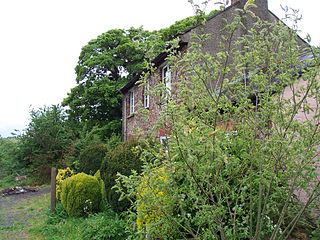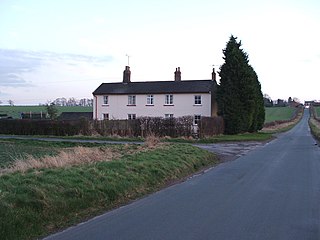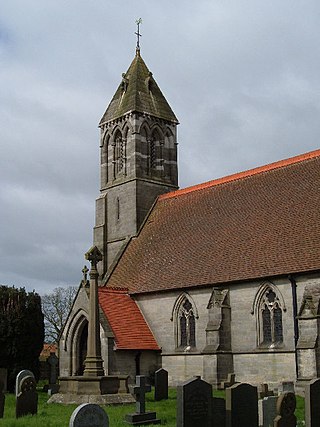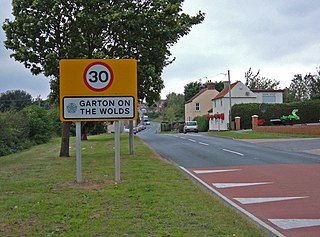
The Yorkshire Wolds are hills in the counties of the East Riding of Yorkshire and North Yorkshire in Northern England. They are the northernmost chalk hills in the UK and within lies the northernmost chalk stream in Europe, the Gypsey Race.

Wetwang is a Yorkshire Wolds village and civil parish in the East Riding of Yorkshire, England, 6 miles west of Driffield on the A166 road.

Sledmere House is a Grade I listed Georgian country house, containing Chippendale, Sheraton and French furnishings and many fine pictures, set within a park designed by Capability Brown. It is located in the village of Sledmere, between Driffield and Malton, in the East Riding of Yorkshire, England. The present house was begun in 1751, extended in the 1790s, and rebuilt after a fire in 1911. It was once the home of Colonel Sir Mark Sykes, 6th Baronet, noted English traveller and diplomatic advisor, and is now the home of Sir Tatton Sykes, 8th Baronet.

Garton on the Wolds is a village and civil parish on the Yorkshire Wolds in the East Riding of Yorkshire, England. It is situated approximately 3 miles (5 km) north-west of Driffield town centre and lies on the A166 road.

Sledmere is a village in the East Riding of Yorkshire, England, about 7 miles (11 km) north-west of Driffield on the B1253 road.

Malton railway station is a Grade II listed station which serves the towns of Malton and Norton-on-Derwent in North Yorkshire, England. Situated on the York-Scarborough Line, it is operated by TransPennine Express, who provide all passenger train services. Once an interchange between four lines, Malton station is now only served by trains operating between York and Scarborough. The station itself is south of the River Derwent, and is actually in the town of Norton in the East Riding of Yorkshire, which for many years was in a different county to Malton.
The Sykes Churches Trail is a tour of East Yorkshire churches which were built, rebuilt or restored by the Sykes family of Sledmere House in the East Riding of Yorkshire, England. The tour was devised by the East Yorkshire Historic Churches Group and is divided into a southern circuit and a planned northern circuit.

The Malton and Driffield Junction Railway, later known as the Malton and Driffield branch was a railway line in Yorkshire that ran between the towns of Malton, North Yorkshire and Driffield in the East Riding of Yorkshire.

Wharram railway station was opened by the Malton and Driffield Railway in May 1853, serving the village of Wharram-le-Street in North Yorkshire, England, although the area was in the East Riding of Yorkshire at the time. The station was also near the deserted medieval village of Wharram Percy and adjacent to Wharram chalk quarry.

Sledmere and Fimber railway station was a railway station on the Malton & Driffield Railway in the East Riding of Yorkshire, England.

Wetwang railway station was a railway station on the Malton & Driffield Railway in the East Riding of Yorkshire, England. It served the village of Wetwang, opened on 19 May 1853, and closed for passengers on 5 June 1950 and goods on 20 October 1958. For passenger traffic, Wetwang was the busiest station on the MDR.

Fimber is a village and civil parish in the East Riding of Yorkshire, England. It is situated approximately 8 miles (13 km) north-west of Driffield town centre and 3 miles (5 km) south-west of the village of Sledmere. It lies on the B1248 road. The civil parish is formed by the village of Fimber and the hamlet of Towthorpe. According to the 2001 UK Census, Fimber parish had a population of 91.

Burdale Tunnel is a former railway tunnel on the abandoned Malton and Driffield Junction Railway (MDR) in North Yorkshire, England. Construction of the tunnel began in 1847, but suffered financial difficulties and building was not complete until 1853. The line was closed completely a hundred years later in 1957, but the tunnel was still being used by members of the public, so the portals were bricked up in 1961. During 1970s and 1980s, there were collapses inside the tunnel and in 2009 the restoration of the passenger line could not continue due to the damage.

Cowlam is a hamlet in the Cottam civil parish of the East Riding of Yorkshire, England, and in the Yorkshire Wolds. The hamlet is on the B1253 Bridlington to North Grimston road, 17 miles (30 km) north from the county town of Beverley, 2 miles (3 km) east from the village of Sledmere, and 2.5 miles (4 km) north-west from the parish hamlet of Cottam. The hamlet contains eight houses and two farms.

East Heslerton is a village in the civil parish of Heslerton, near Malton, in North Yorkshire, England. It lies between the villages of West Heslerton and Sherburn, at the interface between the Vale of Pickering to the north and the Yorkshire Wolds to the south. Heslerton had a population of 409 at the 2011 census. The village was named on early maps as Heslerton Parva.

Helperthorpe is a village in the civil parish of Luttons, in North Yorkshire, England. The village lies in the Great Wold Valley and the course of the winterbourne stream the Gypsey Race passes through it.

The A166 road is a trunk road between the outskirts of York and Driffield in the historic county of Yorkshire. The road used to terminate at the seaside town of Bridlington, until the opening of the Driffield by-pass caused the final section to be renumbered as the A614.

The Thirsk and Malton line was a railway line that ran from a triangular junction on what is now the East Coast Main Line and served eight villages between Thirsk and Malton in North Yorkshire, England. The line was built after a protracted process due to inefficiencies and financial problems suffered by the then York and North Midland Railway.

Wharram is a civil parish in North Yorkshire, England. It lies on the Yorkshire Wolds, 6 miles (10 km) south-east of Malton. The principal settlement is the village of Wharram-le-Street, and the parish also includes the deserted medieval village of Wharram Percy and the deserted medieval villages of Raisthorpe and Burdale, some 3 miles (5 km) south of Wharram-le-Street. The population of the parish was estimated at 120 in 2016.
Burdale is a hamlet in North Yorkshire, England, 8 miles (13 km) south-east of Malton. It lies in a deep valley, also known as Burdale, in the Yorkshire Wolds. It is the site of a deserted medieval village.


















